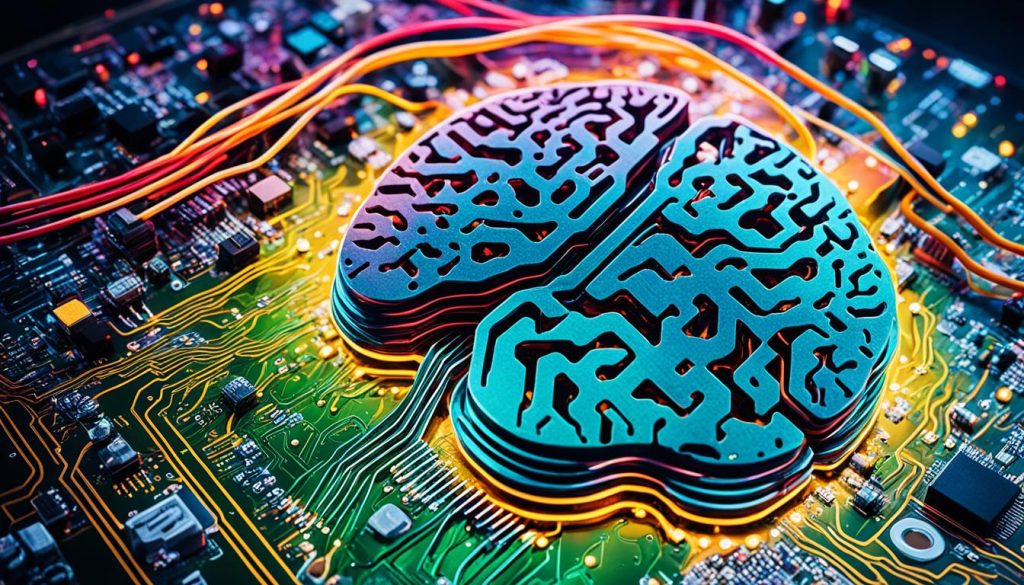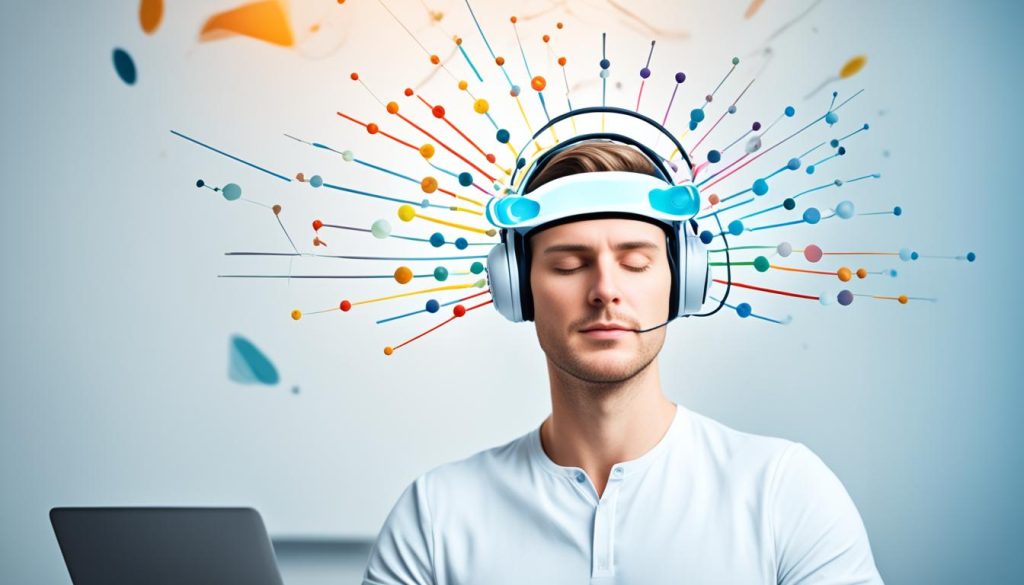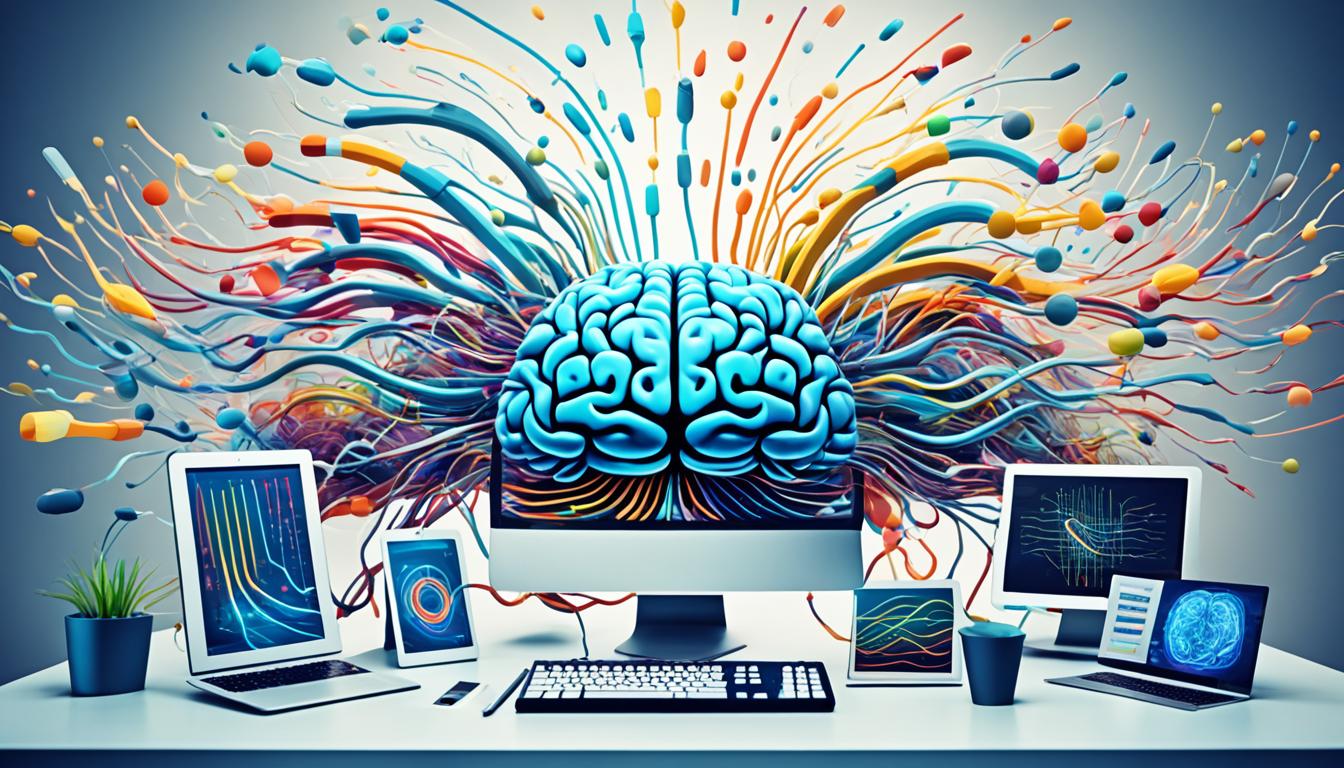Ever thought about unlocking your brain’s full potential with advanced tech? This guide takes you into the exciting world of brainwave guidance technology. It’s a new field changing how we see and enhance our minds. If you’re new to neurotechnology or just curious, this guide is for you. It covers the basics of brainwave technologies and their practical uses.
Quick Recommendation: Our blog aims to give you an understanding of Brainwave Guidance Technology. If you're interested in exploring Brainwave Guidance Technology for relaxation or to enhance your meditation practice, we recommend the InnaPeace program.
What is Brainwave Guidance Technology?
Brainwave guidance technology combines neuroscience with digital innovation. It uses EEG biofeedback to track brain activity. This tech helps people improve their mental states with brainwave guidance techniques.
EEG biofeedback shows your brain’s electrical activity in real-time. This lets you adjust your mental performance for the best results.
Neurofeedback is a key part of this technology. It’s a type of biofeedback that focuses on the brain. By training your brainwaves, you can reduce stress, boost cognitive skills, and even help with ADHD. This makes neurofeedback a key tool in mental health today.
These systems capture brain signals with scalp sensors. They then show specific brainwave patterns. This feedback lets you control your brain activity as it happens. It helps with focus, sleep, and many other areas, with new uses being found all the time.

How Brainwave Guidance Technology Works
Brainwave guidance technology is where neurotechnology and signal processing meet. It uses brain-computer interfaces to connect your brain’s signals to devices. These interfaces help turn your brain’s electrical activity into something devices can understand.
First, brain-computer interfaces record and change your brain’s activity into signals. They use sensors, like EEG, to do this. EEG captures the electrical signals from your brain and sends them to a processing unit.

After capturing the signals, the data goes through complex algorithms. These algorithms make sense of the electrical patterns and turn them into usable data. This lets the technology work with devices, like controlling a computer or moving robotic limbs.
Different Types of Brainwave Frequencies
Exploring the brainwave spectrum can improve your use of brainwave guidance technology. There are five main types of brainwaves, each with unique frequencies and mental states. These include Delta, Theta, Alpha, Beta, and Gamma waves.

Delta waves are the slowest and occur during deep sleep. This state is vital for healing and rest. Being in Delta means you’re getting deep rest and rejuvenation.
Theta waves are linked to creativity and deep relaxation. You find Theta waves in light sleep or deep meditation. This state unlocks creative insights and brings calm.
Alpha waves mean you’re relaxed but still alert. This state is common in quiet reflection or unwinding after a busy day. Beta waves, however, are for alertness and active thinking. They help you focus, solve problems, and make decisions, keeping you engaged.
Gamma waves are the fastest and linked to high-level thinking. Increased Gamma activity means you’re in a super-focused state. This is key for learning and understanding complex information. Understanding these brainwaves helps you use brainwave technology better.
Benefits of Brainwave Guidance Technology
If you want to boost your brain power, brainwave guidance tech could be your answer. It uses special brainwave frequencies to make you more focused and sharp. This leads to a big boost in your thinking skills.

Brainwave guidance is also great for meditation. It helps you relax deeper and stay mindful. This means you can have more meaningful meditation sessions. You’ll feel more balanced and peaceful in your mind.
Studies prove that brainwave guidance is key to reducing stress. It keeps your mind calm, cutting down on anxiety and tension. This is good for your brain’s health overall.
Also, if you’re having trouble sleeping, brainwave guidance can help. It fixes your brainwave patterns for better sleep. This means you’ll wake up feeling refreshed and clear-headed.
In short, brainwave guidance tech has many benefits. It helps with thinking skills, meditation, stress, sleep, and brain health. It’s a great tool for improving your well-being.
Applications of Brainwave Guidance Technology
Brainwave guidance technology is changing how we treat mental health issues. It helps improve your thinking and feelings. This tech is great for people with anxiety, depression, or stress.
This tech is also a powerful tool for personal growth. It helps you learn better and manage your feelings. It makes growing personally more effective and meaningful.

Biohacking fans love brainwave technology for boosting their performance. It lets you check your brain waves to find ways to get better. This leads to better mental and physical health.
In summary, brainwave guidance technology has many uses. It helps with mental health, personal growth, and biohacking. As it grows, we’ll see more ways it can improve our mental and physical health.
Brainwave Guidance Technology in the Medical Field
Brainwave technology is changing healthcare by offering new ways to diagnose and treat conditions. It’s especially useful in treating ADHD and PTSD in clinical settings. This technology uses clinical neurofeedback.
Therapeutic applications of brainwave data are growing fast. They help doctors understand and treat neurological and psychological issues better. By looking at brainwave patterns, doctors can create more tailored treatment plans.
This technology could change how we think about medical care. As it gets better, it might make treatments more efficient and less invasive. This could greatly improve patient care and the healthcare system overall.
Quick Recommendation: Our blog aims to give you an understanding of Brainwave Guidance Technology. If you're interested in exploring Brainwave Guidance Technology for relaxation or to enhance your meditation practice, we recommend the InnaPeace program.
Brainwave Guidance Technology in Education
Educational neurotechnology has greatly improved learning and academic performance. It offers tools to boost brain functions, helping students learn better. Studies show that using brainwave technology in classrooms boosts grades across all ages and subjects.
This technology makes learning more engaging. Traditional classrooms often struggle to keep students interested. But, brainwave technology uses real-time feedback to keep students focused and interested. This is especially helpful in subjects like math and science that need deep focus.
Many schools have added brainwave technology to their teaching methods. They see more students paying attention and doing better in school. As more teachers see its benefits, this technology is becoming more popular. It’s making learning more interactive and effective.
Brainwave Guidance Technology in Entertainment
The entertainment world is now using brainwave guidance tech to change how we interact with games and shows. Imagine playing a game that changes its level of difficulty based on how excited or focused you are. This is what happens with augmented brainwave gaming, where your brain signals change the game.
In virtual reality, this tech takes us to new levels of being there. VR worlds can feel your feelings and change to match them. This makes games and even virtual concerts more personal and fun. It’s like stepping into a story that knows exactly what you’re feeling.
But it’s not just for games. Live shows and theme park rides are now using brainwave tech too. They can change on the spot to match what you’re feeling, making every experience unique. This mix of brainwave tech and entertainment is opening up new ways to connect with what we watch and do.
Challenges and Limitations of Brainwave Guidance Technology
Brainwave guidance technology has made big strides, but it faces challenges and limitations. A big worry is how companies use our brainwave data. It’s important to think about how this private info is handled and if it respects our rights. There are also worries about controlling our thoughts and the need for strong rules to use this tech right.
Privacy is another big issue. These devices collect very personal info, so keeping it safe is crucial. If someone gets into this data without permission, it could be a big problem. This makes us worry about how secure these devices are against hackers.
Also, how accurate these devices are still isn’t clear. Even with new tech, many brainwave devices aren’t very precise. This can make them not very reliable or effective. We need more research to make these devices more accurate. This is important for things like medical treatments, learning, and fun activities.
Future Innovations in Brainwave Technology
The field of brainwave technology is changing fast, thanks to big steps in neurotech. As we look ahead, we see many new things that will change how we study brainwaves.
One big area is the future of EEG technology. New trends are bringing more precise and non-invasive ways to check brain activity. This means doctors will be able to diagnose and treat brain conditions more accurately.
Also, neurotech is leading to better brain-computer interfaces (BCIs). These will make it easier for people to talk to machines. This could change healthcare, education, and entertainment in big ways.
Looking at brainwave technology trends, we see a focus on personal and adaptive solutions. Future EEGs will be made for each person, helping improve brain function and health.
With these new developments, the future of EEG and brainwave tech is very promising. It could change how we understand and work with the human brain.
Understanding Brainwave Guidance Technology: A Beginner’s Guide – Summary
Exploring brainwave guidance technology has shown us a lot. It uses different brainwave frequencies for many benefits. This tech has huge potential in medicine, education, and entertainment.
This summary of brainwave guidance tech explains how it works. It shows how it helps in medicine, education, and entertainment. It improves treatments, helps students focus better, and makes games more engaging.
There are challenges, but new innovations are making it better. These updates promise to grow its impact even more. By understanding these points, you see how far this tech has come and where it might go next.
Conclusion
In this article, you’ve learned a lot about brainwave guidance technology. You now know how it works and its uses in health, education, and fun. You understand how different brainwaves affect us.
Brainwave tech has big promises for us. It can help with mental health, make learning better, and create new kinds of fun. But, we must be careful and think about the downsides to use it right.
It’s key to keep up with new things in brainwave technology. Your knowledge and careful use will help make a big difference. Keep being curious and see how this tech can change our lives for the better.
Quick Recommendation: Our blog aims to give you an understanding of Brainwave Guidance Technology. If you're interested in exploring Brainwave Guidance Technology for relaxation or to enhance your meditation practice, we recommend the InnaPeace program.


Your article helped me a lot, is there any more related content? Thanks!